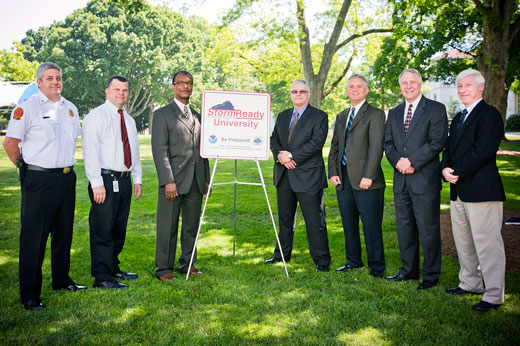Emory has become Georgia's first university to earn a "StormReady" designation from the National Weather Service for developing a proactive response plan to better prepare the campus community for severe weather events.
In a May 15 ceremony on the Emory Quadrangle, National Weather Service meteorologist Barry Gooden formally presented the University with its new "StormReady" certification.
"StormReady" is a nationwide community preparedness program designed to help communities and counties develop public safety plans that take a proactive approach to hazardous weather through improved weather warnings, communication strategies, local weather-spotter training, safety measures and public awareness efforts.
With this recognition, Emory joins more than 130 other universities and nearly 800 communities nationwide to earn the elite designation. In Georgia, 74 counties and two military bases have been named "StormReady."
Campus representatives were on hand to receive the honor, including President James Wagner, Emory Police Chief Craig Watson, DeKalb County Fire Chief Edward O'Brien and representatives from Emory's Office of Critical Event Preparedness and Response (CEPAR), which had applied for the designation.
"We sought the designation because it signifies a high degree of preparedness for weather emergencies and validates that you have a robust system in place to educate the public, so they have a better understanding of what to do in the event of dangerous weather," says CEPAR Senior Administrator Samuel Shartar.
To earn the designation, a community or campus must:
Establish a 24-hour warning point and emergency operations center;
Demonstrate more than one way to receive severe weather forecasts and warnings and to alert the public;
Create a system that monitors local weather conditions;
Promote the importance of public readiness through community seminars;
Develop a formal hazardous weather plan, which includes training severe weather spotters and holding emergency exercises.
In applying for the "StormReady" designation, Shartar says he discovered that Emory already had already met much of the emergency preparedness requirements.
"Mostly, we had everything in place," he says. "The only thing we added was training to educate storm spotters about what dangerous clouds look like and how to estimate wind speed by looking at the level of damage that it creates."
Not only does the "StormReady" designation help bolster ongoing efforts to create a safe campus community, but the recognition "is a nice bragging right — one we're happy to have," Shartar adds.
For more information about what to do on campus in the event of hazardous weather, visit emergency.emory.edu or consult CEPAR's online emergency preparedness checklist.

